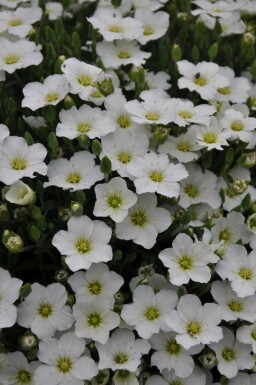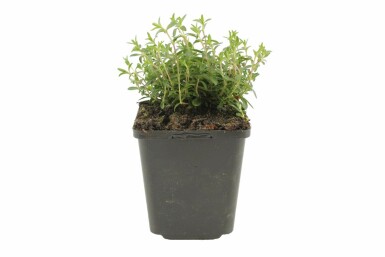

25cm



Updated on 10 September 2025
We regret to inform you that we are currently unable to ship orders to the United Kingdom. We anticipate being able to resume shipments at the beginning of 2026.
Arenaria thrives in rock gardens and dry spots, forming a dense mat of fine foliage. This low-maintenance plant is ideal for ground cover, offering abundant small white flowers that tolerate drought. Perfect for edge planting and walls, enhancing any garden.


25cm



Arenaria is a charming plant that brings a touch of Alpine beauty to any garden. This low-growing mat features narrow leaves and small, star-shaped white flowers. It blooms from spring to summer and is ideal for rock gardens and dry spots. Its compact nature makes it perfect for use as ground cover or in low borders. The cushion-like form of Arenaria adds structure to rock gardens and stacked walls. Discover the unique appeal of this versatile plant and explore how it can transform garden spaces. For those interested in adding this stunning plant to their garden, consider exploring options to buy Arenaria seedlings UK. Enhance the allure of your outdoor area with the enchanting presence of this lime-loving, carpet-like rock plant.
Arenaria, commonly known as sandwort, is a small flowering plant that belongs to the Caryophyllaceae family. This resilient perennial is perfect for gardens needing a cushion plant. Sandwort is often used as a groundcover or in rock gardens, wall planting, and planters. It is highly drought-tolerant, making it ideal for areas with low water availability. The name Arenaria comes from the Latin word ‘arena,’ meaning sand, symbolising simplicity and stability. It can be found in various regions, including Europe, North Africa, and Central Asia. In its natural habitat, Arenaria acts as a mat-forming ground cover, preventing erosion on mountain slopes. This makes it not only beautiful but also ecologically important. Sandwort grows best in sandy or rocky soil and can thrive in cracks and crevices, making it versatile for many garden settings. With its hardy nature, it is a popular choice among garden enthusiasts looking to buy Arenaria for their rock-garden groundcovers. In monastery rock gardens, it is revered for its simplicity. Consider planting Arenaria to enhance your garden’s natural beauty and stability.
Arenaria, a perennial favourite, thrives in sandy or rocky soils. It grows in a compact, cushion-forming shape, making it ideal for cracks and crevices. This hardy plant serves as a groundcover and is perfect for rock gardens, edge planting, and even wall planting. Arenaria matures from small, narrow leaves into a lush carpet-like ground cover. Arenaria is a compact variety among the perennials well suited to rock gardens. The plant's development begins in spring, with a steady growth pace leading to its mature form. Usually, Arenaria blooms from May to July, producing small, five-part star-shaped flowers in white or occasionally pink hues. Factors such as climate, temperature, and soil play essential roles during the blooming period. Well-drained soil and proper care also impact flowering success. The plant blooms in vibrant white, although pink variations exist depending on the cultivar and environmental conditions. Its flowers are mainly influenced by the soil pH, available light, and the plant's age. The fragrance of Arenaria is subtle, with scent varying based on the blooming stage and the specific variety. Typically, Arenaria grows to a mature height ranging from 5 cm to 30 cm, depending significantly on the species, location, and care provided. Arenaria's adaptability to drought and its lime-loving nature make it a reliable choice for gardeners, enhancing biodiversity with its unique appeal.
Arenaria plants have small, narrow oblong to linear leaves that are often felted. These leaves are light green to grey-green, and sometimes have a silvery hue. The thick, small leaves of Arenaria are well adapted to resist wind and cold. In winter, Arenaria remains evergreen, providing a cushion of foliage. This resilience is due to its low-growing form and the protective nature of its leaves. The plant is winter hardy, thriving in USDA zones 5 to 6, withstanding temperatures as low as -29°C. It is suitable for rock gardens in cold climates. Arenaria retains its foliage year-round, unlike many perennial plants. Factors influencing this include its genetic makeup and preferred climate and location. The plant's hit to resistance is notable. With origins in rocky, alpine regions, Arenaria copes well with heat and drought thanks to its small, tough leaves and efficient water usage. Arenaria is safe for gardens with children and pets as it is non-toxic. It can be used comfortably in any garden setting. The plant enhances biodiversity by providing habitats and food for insects and birds. Its small, white flowers bloom in late spring, making it a popular choice for gardeners looking to cultivate Arenaria montana in pots or as a white-flower groundcover for gravel gardens in the UK. As a rockery plant, Arenaria helps maintain ecological balance by supporting local wildlife.
Arenaria is perfect for adding a touch of greenery to rockeries, paths, and gravel spaces. This plant is known for its ability to thrive in dry and rocky conditions, making it an excellent choice for these areas. The low maintenance and resilience of Arenaria make it an ideal addition to any garden looking for a robust ground cover option. - Arenaria can be used as a ground cover, providing a lush green carpet that hugs the ground and fills in gaps between stones or along pathways. - It is perfect for rock gardens, where its alpine mat-like appearance enhances the rugged beauty of rocks and stones. - Edge planting with Arenaria creates a neat border along paths and patios, helping to define spaces while adding a touch of softness. - Wall planting with Arenaria is also possible; its ability to grow in challenging conditions makes it suitable for draping over stacked walls or filling in crevices. - Group planting of Arenaria in pots or planters can create striking displays on terraces or balconies, giving the area a vibrant and natural feel. With its cushion plant quality, Arenaria offers both aesthetic and practical benefits in various garden settings. Sandwort not only adds texture and colour but also requires minimal care, making it an attractive choice for gardeners aiming for effortless beauty. Consider introducing Arenaria into garden designs, and enjoy the charm it brings to outdoor areas. Those interested in enhancing their garden can find this versatile plant easily, so be sure to explore options to buy sandwort for the next landscaping project.
Arenaria forms a compact ground cover that pairs easily with other garden plants. This versatile plant is perfect for rock gardens and dry spots. When looking to enhance the beauty of a garden with Arenaria, consider combining it with other low-growing plants. Thymus complements Arenaria well. Its aromatic foliage and small flowers add texture and scent. Sedum is another excellent choice. Its thick leaves and varying colours provide a nice contrast against Arenaria’s green mats. For more colour, try Dianthus deltoides. This plant’s vibrant flowers create a striking visual. Campanula portenschlagiana adds a touch of blue, providing a charming mix. These combinations are not only visually appealing but also practical. Many thrive in similar conditions, like dry and sunny locations, where Arenaria naturally fits. Additionally, these plants enjoy lime-rich soils, making them ideal partners. Pairing these varieties with Arenaria helps create a consistent and lush carpet-like rock plant garden, giving a vibrant look to borders and walls.
Arenaria thrives in full sun, making it perfect for sunny spots in the garden. This plant loves well-draining, sandy soils, making it a great choice for dry, stony areas. Full sun ensures that Arenaria develops its best form, so consider placing it where it can bask in sunlight. Wind can be a factor, but Arenaria's low-growing form and thick leaves help it resist strong winds and cold. If wind is a problem, planting near rocks or a windbreak can help. For soil, calcareous and stony alpine types are ideal. Arenaria benefits from a well-draining environment; a soil mix with sand or small stones can improve drainage. Regular fertilisation supports healthy growth. Soil moisture should be moderate; too much water can harm the plant, especially if coupled with poor drainage. The soil pH preference is neutral to slightly alkaline. Factors such as the existing soil type and climate can affect this, so testing soil pH can be helpful. Keeping these needs in mind can help Arenaria, also known as an alpine mat or rockery plant, flourish in a rock garden setting.
Arenaria can be planted in spring or late summer, ideal for rock gardens and crevices. When planting, consider soil conditions and ensure the area receives full sun; Arenaria (sandwort) thrives in dry, well-drained, calcareous sandy soils. Plants delivered in pots can be planted year-round, except during frost, while those with root balls are best planted in spring or autumn. For optimal growth, plant Arenaria with sufficient space, considering the plant's size, growth rate, and desired coverage. The number of plants per metre is typically specified on the Heijnen product page, which helps in achieving a carpet-like effect. Before planting Arenaria, it's essential to prepare the soil properly. Ensure the soil is very well-drained and consider adding gravel or fine chippings to improve drainage. Heijnen anplantgrond is recommended for best results. When planting, position Arenaria shallowly and water sparingly, as the plant is sensitive to wet feet. Post-planting care involves monitoring the moisture level and ensuring the soil remains dry. Regularly check the position to make sure the plants receive plenty of sunlight, adhering to their full sun requirement. Consistent care will help Arenaria develop into a compact ground cover.
Arenaria is a charming plant for any garden, thriving in sandy or rocky soil and perfect for rock gardens. Known for its mat-forming ability, it serves as a durable groundcover. In late spring, it delights with its flowering. Here are some essential care tips for Arenaria (sandwort):
Arenaria is a popular choice for rock gardens due to its charming appearance and ease of care. This plant features small white flowers, sometimes pink, which bloom in star shapes. The flowers create a carpet-like effect that complements other flowering garden plants. Arenaria has light green to grey-green leaves, occasionally silvery, adding a unique texture to the garden. Sandwort is not only visually appealing but also serves as a habitat for insects, providing both shelter and a food source. Its compact, cushion or mat-forming growth makes it ideal as a ground cover, especially in dry spots or among stacked walls. Known for its tolerance to drought, Arenaria is a low-maintenance addition to any garden. Its dense mat-like structure adds a natural touch to rock gardens and fits well in alpine settings. With its preference for sandy or rocky soil, Arenaria thrives in lime-loving environments. The plant's versatility and resilience make it an excellent choice for gardeners seeking a functional yet decorative plant.
Arenaria, commonly known as sandwort, is a charming choice for gardens across the UK. These plants are favoured for their cushion-like appearance and ability to thrive in rock gardens. Known for their hardiness, Arenaria species are perfect as alpine mats or as a white-flower groundcover for gravel. The following are some of the most popular varieties of Arenaria that are cultivated successfully.
Arenaria (sandwort) is a popular choice for gardeners looking to enhance their outdoor spaces. This plant offers several advantages but also comes with a few challenges.
Advantages:
Disadvantages:
Proper soil preparation, placement, and regular care, including timely fertilisation, can reduce the risk of diseases and pests. Ensuring the plant is well-cared for will promote its growth and blooming.
We would like to provide some tips on how to plant and care for a Arenaria. By following these tips, you can be sure to enjoy your Arenaria for a long time.
Arenaria thrives in sunny locations with well-draining, dry, sandy soils, making it perfect for rock gardens and borders. The key to success is ensuring a site with full sun exposure. This environment promotes better growth and richer blooms. Arenaria's thick, small leaves help it withstand wind and cold, ideal for calcareous, stony alpine soils. It grows best on dry ground, requiring minimal water, which enhances its resilience and resistance. The versatile plant is perfect for ground cover, rockery gardens, and wall planting. Its low-growing form makes it suitable for edging and planting in pots or planters. The right location is crucial for its growth and flowering. Plant Arenaria in spring or late summer, and enjoy its robust presence with little maintenance needed. Sandwort, being drought-resistant, adds charm to any garden setting.
Preparing the soil is crucial before planting Arenaria. Start with good soil preparation, turning the earth to improve water drainage and mix in compost or a special planting soil. This helps provide nutrients and enhances soil structure. Well-worked soil ensures sandwort can thrive by allowing water to pass through easily, preventing root rot. Arenaria prefers calcareous, stony alpine soils and grows well in sunny spots. It's best to plant in spring or late summer, avoiding frost periods. If planting potted sandwort, it can be done year-round, except during frosts. For root-balled sandwort, plant in spring or autumn and keep the jute bag intact. Water the plants well after planting and continue until they establish. The size of Arenaria determines how many can be planted per square metre. Give these hardy plants a well-drained, sunny spot for best results.
Fertilising Arenaria is crucial for healthy growth and vibrant blooms. Proper feeding ensures robust development and helps maintain the plant's vitality. It is recommended to use organic or organic-mineral fertilisers from Heijnen for the best results. These fertilisers promote good growth, rich blooms, and overall plant health. Arenaria benefits from feeding twice a year, with light compost applied in spring and summer. Liquid fertiliser is only necessary if flowering stalls. The exact amount of fertiliser depends on the plant size; larger plants require more. Nutrients are absorbed when they dissolve in water, so it's important to water the garden during dry spells after fertilising. This ensures nutrients reach the soil and roots effectively, supporting the sandwort's growth and health.
Arenaria is best pruned in early spring. Light pruning after flowering helps the plant maintain a tidy appearance. This is important for its role in the garden. Removing spreading branches keeps it in shape and encourages healthy growth. Regular pruning benefits the plant by promoting new growth, enhancing its appearance, and preventing it from becoming too leggy. For best results, use sharp secateurs to ensure clean cuts. Good tools make a significant difference, as they prevent damage to the plant. Always aim for a neat cut, which aids in healing and reduces stress on the plant. Taking the time to prune Arenaria carefully is rewarding and ensures a thriving addition to the garden.
Arenaria needs regular watering when first planted to help establish roots. Once settled, it requires water only in extreme drought. It's important to give a lot of water when needed instead of little amounts daily. Check soil moisture before watering to ensure it's necessary. Watering during early morning or late afternoon is best to reduce evaporation. Make sure excess water can drain away, whether in garden soil or pots. Drip irrigation systems work well once roots are established, but additional watering is needed when planting. Arenaria is highly drought-tolerant, making it suitable for dry, rocky gardens. Remember, even drought-resistant plants need some care during extreme conditions. Sandwort is another name for this resilient plant.
Arenaria is known for its small white flowers and fine foliage. It forms a dense mat, making it ideal for rock gardens. This plant symbolises simplicity and stability, often found in monastery gardens. Arenaria is low maintenance and drought-tolerant, providing abundant blooms. It is safe for children and pets, with no known toxicity. Sandwort is an excellent choice for gardeners seeking a durable and decorative option in their gardens.
Arenaria, a popular choice in gardens, benefits from division to maintain its vibrant growth. Dividing Arenaria rejuvenates the plant and helps remove old parts. This process keeps the plant healthy and compact. Division in spring is ideal for Arenaria, as it promotes fresh growth. To divide, carefully dig up the plant and separate younger parts from older ones. Replant the young sections to encourage new growth. It's recommended to divide Arenaria every three to four years. Autumn is not the preferred time for this task. Use a sharp spade or garden knife for clean cuts during the division process. Routine care and maintenance ensure Arenaria continues to thrive.
Sandwort is a wonderful choice for a rock garden. This low-maintenance plant forms a dense mat, making it ideal for ground cover. With its small white star-shaped flowers and light green foliage, sandwort brings beauty to any garden. It tolerates drought well, blooms abundantly from spring to summer, and helps prevent erosion. Order the delicate Arenaria (Sandwort) from Heijnen for a blooming carpet in your garden.
